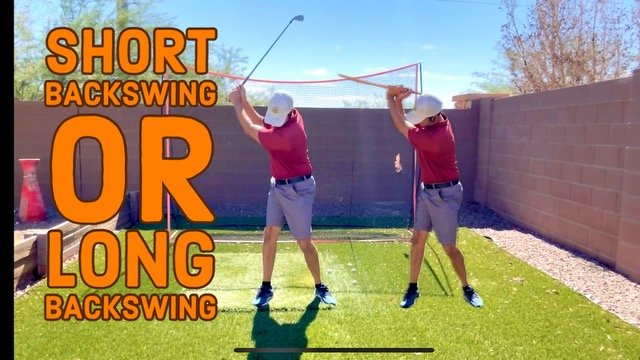Do you struggle with your golf swing’s backswing? Whether it’s too short and limiting your distance or too long, causing control issues, we’ve got you covered. In this blog post, we’ll discuss both scenarios, providing insights and practical tips to help you refine your golf swing.
You can watch the video here or keep on reading:
https://youtu.be/QTGaceE7wTE?si=dgo1nnNqFySskykN
When your backswing feels shorter than desired, there are a few key factors that may be limiting your potential. Let’s dive into why your backswing might be too short and how to address these issues:
- Tight Hips: Many golfers struggle with limited hip flexibility. To enhance your backswing’s length, try turning your right foot outward slightly. This adjustment can help you rotate your hips more, setting the stage for a longer swing.
- Limited Wrist Set: If you’re not setting your wrists adequately during your backswing, your swing will naturally be shorter. To fix this, focus on letting your wrists set more, creating the “L” position in your swing.
- Rushing the Backswing: A fast backswing can lead to a shorter swing. Slow down your backswing, setting your wrists and allowing your body to rotate properly.
To help improve the length of your backswing, consider these useful tools and drills:
- The Orange Whip: This training aid can promote a smoother and more extended backswing by encouraging a fluid tempo and swing rhythm.
- Weighted Golf Clubs: Find weighted clubs to build strength and increase flexibility, contributing to a longer backswing.
- Stretching Exercises: Incorporate stretching routines into your golf fitness regimen. Increased flexibility can lead to a more extensive backswing.
When your backswing becomes excessively long, it can lead to control issues and inconsistent results. Here are some common pitfalls:
- Excessive Arm Bending: Allowing your right arm to bend significantly and your left arm to collapse can lead to an overly long backswing. This creates too many angles to manage, causing control problems.
- Exaggerated Wrist Set: Overly setting your wrists can lead to a loss of grip and a casting motion, impacting the consistency of your swing.
- Loss of Posture: Losing your posture by standing up during your backswing can result in a long, but less controlled swing. Maintaining proper posture is crucial for consistent ball striking.
To rein in a lengthy backswing, consider these corrective measures:
- Maintain Left Arm Length: Focus on keeping your left arm extended as long as possible during the backswing. This prevents unnecessary angles and promotes control.
- Limit Wrist Set: Avoid excessive wrist set and maintain a smoother, less abrupt transition in your swing. This will help you regain control of the clubhead.
- Preserve Posture: Concentrate on keeping your posture consistent throughout your backswing, rather than standing up or changing your spine angle.
Using Training Aids:
For both short and long backswings, a practical training aid to consider is the Swing Glide. This simple tool helps you maintain a 90-degree wrist angle, a crucial element in controlling your backswing length.
Here is a link to a Swing Guide- (I do earn a small commission)
- Short Backswings: The Swing Glide will help you set your wrists correctly, ensuring a more extended backswing.
- Long Backswings: This tool encourages a more controlled wrist set, preventing excessive angles and casting.
Remember, no training aid can replace practice and self-assessment. Use tools like the Swing Glide as a guide to achieve the correct wrist angle, and then remove it periodically to ensure that you can replicate the feeling without assistance.
Improving your golf swing’s backswing length is an essential step in becoming a more consistent and powerful golfer. Whether you’re dealing with a short or overly-long backswing, understanding the underlying issues and employing corrective measures can help you find the right balance. Use the recommended tools and drills, focus on wrist control, and maintain proper posture to enhance your swing. With practice, feedback, and dedication, you can achieve a well-balanced and effective golf swing.
Is this conversation helpful so far?

